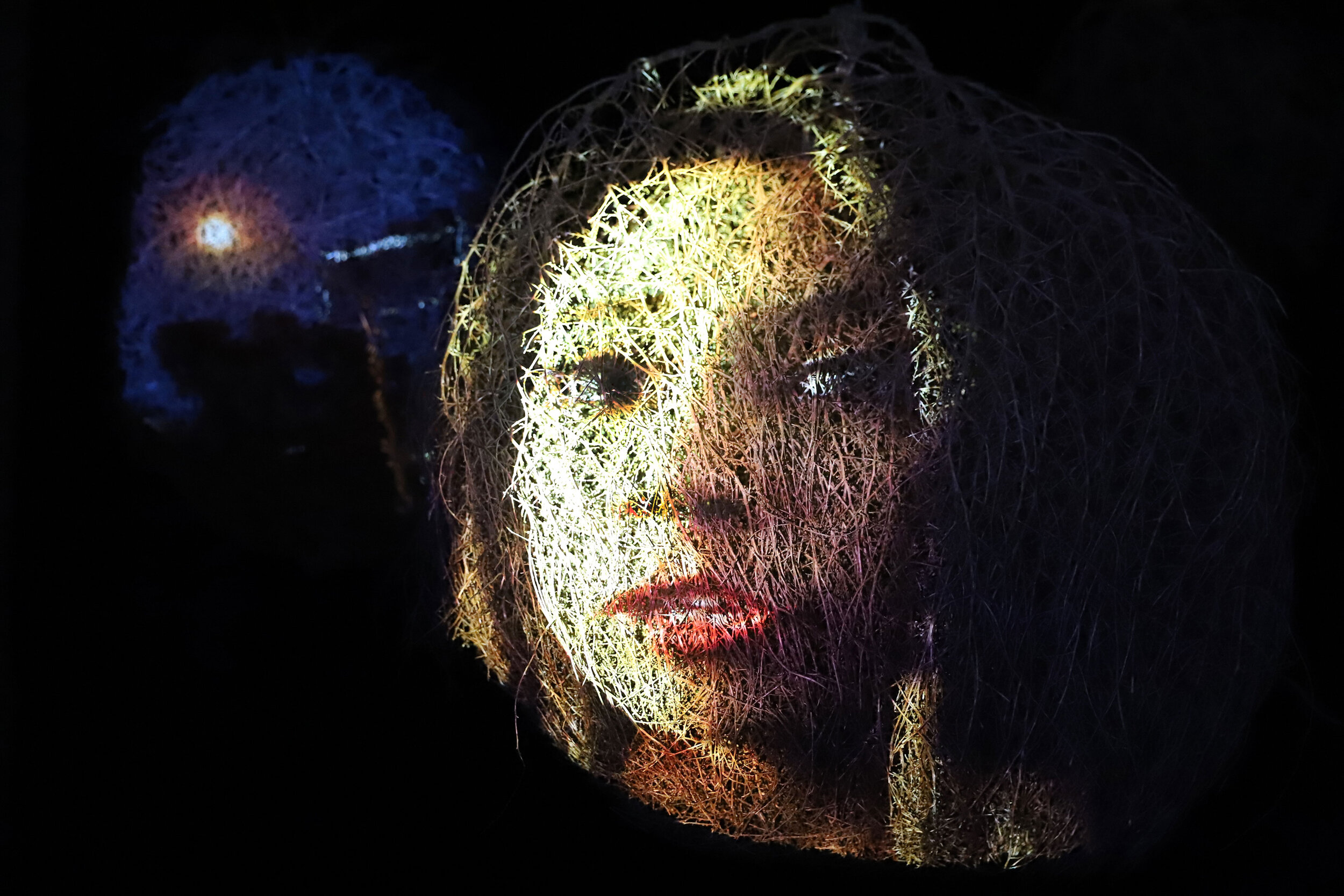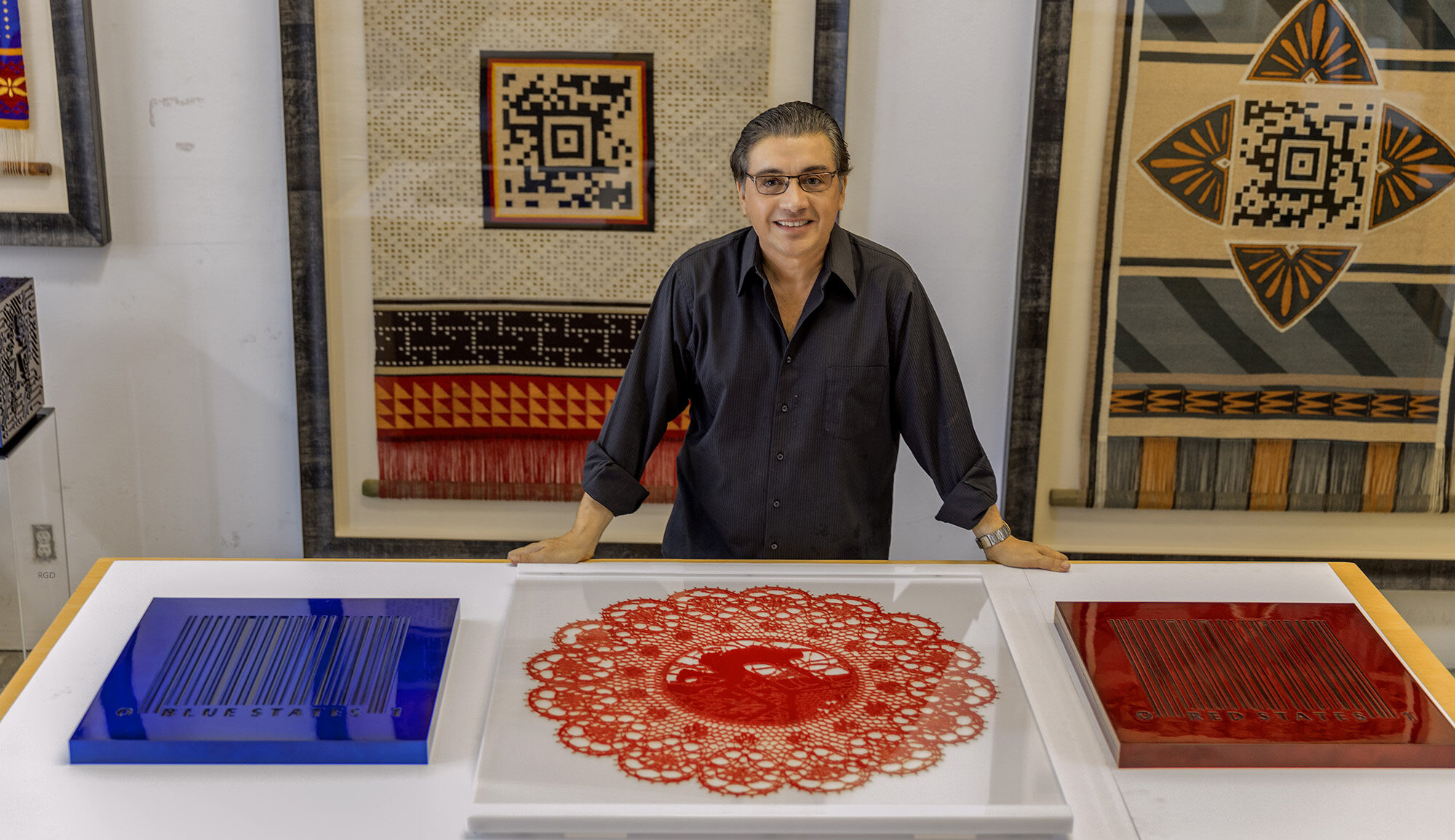Los Angeles-based mixed media artist Guillermo Bert was born in Santiago, Chile in 1959. His bi-cultural experience provides him with a lived perspective from which his artistic expression is cultivated – focusing on the signs and symbols of urbanism, consumerism, and displacement. A trip home to Chile in 2010 marked a turning point in his work. Through his experience with the indigenous Mapuche community, he was inspired to work with traditional weavers, combining QR codes woven into the textile designs. These “high tech” QR codes, when scanned with a smartphone, take the viewer into a filmic world of story, myth and reflection by Mapuche elders, activists and poets. Extending this idea, Bert continues to experiment with this multi-layered format, collaborating to date with Mapuche, Navajo, Maya, Mixtec and Zapotec weavers. The result is Encoded Textiles, a series of 40 embedded films that “de-code” cultural messaging and create a bond between the distant viewer and the intimacy of the community of indigenous artists and storytellers.
Recently, Bert developed the series Tumble Dreams, supported by the City of LA COLA Grant. This series was based on video testimonials of immigrants mapped through projections onto Tumbleweeds. These projections allude to the nomadic journey though the desert of these immigrants aspiring to reach a better life.
For more information, please see: Gbert.com, and on Instagram @guillermobert.
Guillermo Bert, The Visionary, 2012. Wool & natural dyes encoded with an Aztec bar-code. Woven by Anita Paillamil. 88 x 52”. Image courtesy of the artist.
First, and most importantly, how are you doing? How are you navigating the highs and lows?
I try to keep centered and not focus on thoughts leading to anxiety or fear. I prefer to get out of my head and stay focused on my work and family, keeping a low profile. As a family, we have been able to keep cool - cooking and playing games at the dinner table, so that we can remain not only present but grateful that we have each other during these solitary times. Aside from home life, I’m extremely concerned about the dysfunction of our government and the mishandling of the Corona Virus pandemic. Thankfully, I have a large studio where I spend most of the day, which allows me to focus on some ideas I have been working on for some time.
Guillermo Bert, Redemption, 2012. Wool & natural dyes encoded with an Aztec bar-code. Woven by Anita Paillamil. Image courtesy of the artist.
It's my experience that most artists engage with some level of self-isolation in their day to day art practice. Has this been your experience? And if so, have you found these innate rhythms to be helpful during this larger, world-wide experience of isolation?
Yes, the isolation has been not a bad thing. I can work on and develop new ideas, and advance projects that have previously been left behind. It has also allowed me to focus and reshape some of my ideas to fit the new concerns and questions that arise from these intense and unexpected world-wide experiences.
With the culmination of last year, which was very busy with shows in New York, Europe and elsewhere, this transition has definitely been a change of pace. This time for reflection has allowed me to refine and create some new pieces, and I’m looking forward to when our works can be presented again.
Of special note is the recent acquisition of my piece – La Bestia (The Beast) - by the Los Angeles County Museum of Art (LACMA). This was through a museum fundraising event that was originally scheduled to occur about 8 months ago, but was postponed because of the Corona Virus pandemic and the closing of LACMA. Eventually, the curators were able to have the event coordinated on-line through Zoom. The acquisition made through this on-line event to support the museum was exceptionally high, which of course made everyone very happy.
Guillermo Bert, LA BESTIA (The Beast), 2017. Wood & natural dyes with Aztec Bar-code. 60 x 34”. Image courtesy of the artist.
This piece was woven by a Mayan community of weavers in San Martin Chiquito, Guatemala, as part of the “Encoded Textile Series.” It depicts the freight train, La Bestia, carrying immigrants from Guatemala and Central America to the Southern border of the United States. The woven-in code is meant to be scanned on a SmartPhone, and it tells the story of one immigrant who traveled for 10 days on the roof of the train across Mexico to the end of the line. He was interviewed in Los Angeles, CA. (in Spanish with English and French captions.)
It would be great if you could briefly talk us through your practice. Understanding it is integral to appreciating the multivalence of your work.
My work plays on the idea of “borders” by framing the experience of trans migrants - immigrants whose lives depend on constant interconnections across international borders - in their own words through film and audio recordings embedded in textile designs. These works are meant to portray the dizzying effects of migratory crossings and the urban global economy of Los Angeles. This new approach to investigative art-making explores the complications and contradictions that come with that crossing, when the hope of the American Dream is met with the dark side of living in its shadows.
The weavings being created propose a new mythology of cultural innovation. Using the data embedded in the “bar codes” that are woven into the designs, they aim to restore and reinsert the indigenous migrant experience into the local Los Angeles cultural narrative, as well as the global dialogue with immigrants of Latin American origins.
Just as the art work allows viewers to “de-code” the migrant experience in a participatory role (i.e., by “reading and activating” the coded stories with their smartphones), the series aims to bring together interdisciplinary forms of weaving and story-telling to mark and contrast the inter-relationships of these traditional art forms with 21st century media. The multi-media aspects of the project stand as a testimony to cultural life through documentary inquiry and observation. The project allows me to further my work as a filmmaker and multi-media artist, while expanding and deepening the content of indigenous living history through art as a vehicle for public engagement with the pressing issues of our time.
Guillermo Bert, LUKUTUWE (Fertility), 2012. Wool & natural dyes encoded with an Aztec bar-code. Woven by Anita Paillamil. 88 x 52”. Image courtesy of the artist.
Has any of your imagery shifted in a reflection to what's currently happening? And why, or why not?
I normally process these sorts of world issues slowly, but I’m paying close attention to the slew of fast changing global current events that have been occurring, and this onslaught of information requires me to reflect more deeply on how it all not only affects me, but others around me, as well. I am sure that by the end of the year my reflections of these concerns will materialize into new images, ideas and approaches for my future pieces. I am still working on ideas related to immigration and the impact of technology in the perception of history and ancient cultures.
Guillermo Bert, Psalmo 1492, 2012. Wool & natural dyes encoded with an Aztec bar-code. Woven by Anita Paillamil. Image courtesy of the artist.
Are you thinking differently? Coping differently? Inspired differently?
The change of pace due to the pandemic has definitely altered how I approach my work. As opposed to spreading my attention across multiple projects all at once, I now focus on what is in front of me and work on one thing at the time. This allows me to more fully concentrate. Fortunately, I have many ideas in the process of being developed, so I am making good use of my time.
Guillermo Bert, TUMBLE DREAMS #6, 2018. Video Installation Mapping Projection on tumble weeds; Installation piece: 14’ high x 20’ wide x 12’ deep. COLA Grant Exhibition at Barnsdall Park Art Gallery, Los Angeles, CA. Image courtesy of the artist.
The tumble weed is used as a metaphor for the nomadic lives and destinies of the immigrant peoples along the Southern border of the United States. The room was painted black and the tumble weeds were suspended from the ceiling while the individual interviews were simultaneously projected onto the weeds. (Spanish with English captions.)
What is bringing you solace, or even joy, in this moment?
The main things that have been bringing me joy of late have been my family and the prospect of an upcoming political change. I also think that the ways we communicate and share ideas with each other will be impacted, hopefully for the better.
Guillermo Bert, TUMBLE DREAMS #1, 2018. Video Installation Mapping Projection on tumble weeds; Installation piece: 14’ high x 20’ wide x 12’ deep. COLA Grant Exhibition at Barnsdall Park Art Gallery, Los Angeles, CA. Image courtesy of the artist.
What research or writing are you doing that you find compelling?
I’m currently focused on 3-D scanning and creating sculptures based on scanned models, sometimes working with LED lights and other laser techniques that are coming along quite interestingly. I love new technologies, but not just because they are cool, which they are, but because of the way they can expand people’s perceptions. We are in the middle of a huge digital revolution, and that is why technology should be part of the lexicon of the artists of the future.
Guillermo Bert, TERRA COTTA #1, 2020. Laser-cut oak wood. 60 x 20 x 12”. Image courtesy of the artist.
Based on a 3D model of a pre-Columbian terra cotta figure. Thin layers of wood are held together with thin metals bars, and this technological process lends the work a Post-Modern appearance, placing it between the ancient and contemporary.
Are you reading anything?
Recently, I have been brushing up on historical facts and researching our political situation; I also look at documentary films when they are of interest. There is a lot to learn and I believe my work will continue to develop as I am better able to connect the current issues of our time in a way that speaks to 21st century people in a relevant way.
Guillermo Bert. Image courtesy of the artist.









